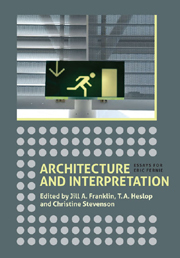Book contents
- Frontmatter
- Contents
- List of Illustrations
- Preface: In Appreciation
- List of contributors
- 1 Introduction
- Incitements to Interpret in Late Antique and Medieval Architecture
- Authors and Intentions
- Architecture beyond Building
- 266 Innovation and Traditionalism in Writings on English Romanesque
- 284 Why Medieval Ireland Failed to Edify
- 306 The Chapel of the Hospital of Saint-Jean at Angers: Acta, Statutes, Architecture and Interpretation
- 315 Sealed Architecture: City Seals, Architecture and Urban Identity in the Northern Netherlands, 1200–1700
- 333 Style and Geography: Struggles for Identification in the Later Nineteenth Century
- 343 The Dome of the Rock: From Medieval Symbol to Modern Propaganda
- 357 Towards a Cultural Geography of Modern Memorials
- 381 Bicycle Sheds Revisited, Or: Why are Houses Interesting?
- Index
333 - Style and Geography: Struggles for Identification in the Later Nineteenth Century
from Architecture beyond Building
Published online by Cambridge University Press: 05 April 2013
- Frontmatter
- Contents
- List of Illustrations
- Preface: In Appreciation
- List of contributors
- 1 Introduction
- Incitements to Interpret in Late Antique and Medieval Architecture
- Authors and Intentions
- Architecture beyond Building
- 266 Innovation and Traditionalism in Writings on English Romanesque
- 284 Why Medieval Ireland Failed to Edify
- 306 The Chapel of the Hospital of Saint-Jean at Angers: Acta, Statutes, Architecture and Interpretation
- 315 Sealed Architecture: City Seals, Architecture and Urban Identity in the Northern Netherlands, 1200–1700
- 333 Style and Geography: Struggles for Identification in the Later Nineteenth Century
- 343 The Dome of the Rock: From Medieval Symbol to Modern Propaganda
- 357 Towards a Cultural Geography of Modern Memorials
- 381 Bicycle Sheds Revisited, Or: Why are Houses Interesting?
- Index
Summary
IN THE HISTORY OF ART the term ‘style’ has been a long-lasting one; in fact, of all signification systems, it must rate as one of the most successful. It is taken as axiomatic that each and every work of art ‘possesses’, or enunciates a style. Among the different media of the visual arts, it is architecture which seems most strongly and most clearly connected with the concept of style. At the very least, a limited range of such style labels is quite widely known. As early as 1833 John Claudius Loudon held that ‘by the employment of style in an edifice … the architect gains a positive beauty at once, because thousands of spectators in Europe and America … have some crude ideas of what is Grecian and what is Gothic’.1 Much the same can be said about the applied arts, certainly those which are closely tied in with buildings, notably all branches of interior furnishing. And yet, upon closer inspection, the homogeneity of the system of ‘style’ dissolves into a number of quite diverse factors. Moreover, all these factors went through a complex process of creation and development.
This contribution seeks to explain a phase in the history of the formulation of ‘style’ in which the geographical component, in particular, seemed of overriding importance. Place – the locality where the work in question was made – is held to have been a major factor in shaping a work of art, particularly a stationary one, such as a building. This contribution traces some of the controversies regarding the formulation, and eventual acceptance, of several geographical style labels.
Information
- Type
- Chapter
- Information
- Architecture and InterpretationEssays for Eric Fernie, pp. 333 - 342Publisher: Boydell & BrewerPrint publication year: 2012
